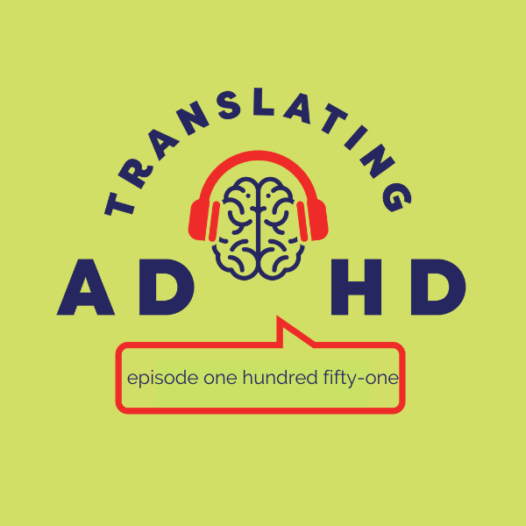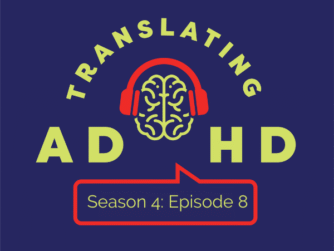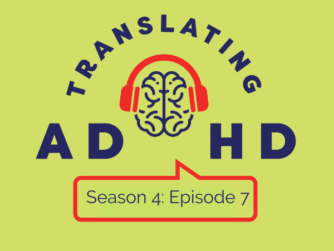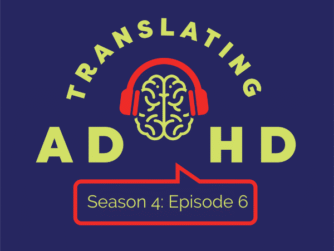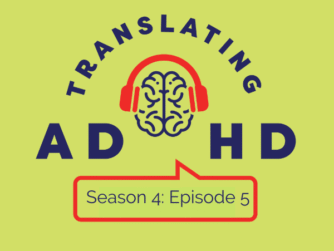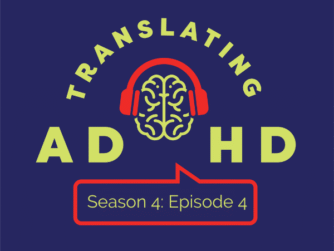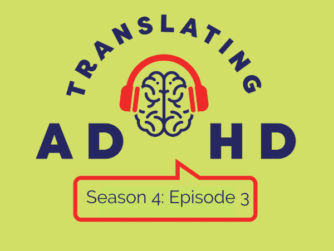Cam and Ash continue to explore important ADHD distinctions around basic needs as they dig into belongingness and love needs. Humans will often seek out connection more so than other basic needs, especially those in the self care arena. The need for acceptance and validation can be a giant big signal for those of us with ADHD. It feels good to be at the service of others but in overextending or seeking external validation, we can lose sight of ourselves – our own authentic Who.
The hosts talk about the importance of self acceptance and how uncovering strengths and operating out of a strength mindset can lead to self acceptance. Asher shares how in our One Down perspective we can feel a need to make up for… – to make up for our perceived challenges and weaknesses. He shares an example of a client who thinks they need to be more like The Politician – someone in the client’s workspace who exudes confidence and competence in the moment. Leading with strength-based coaching, Ash and his client discover how his own strengths can support his goals and show up as a capable and confident leader, but true to his own authentic self.
The hosts talk about how the blame sponge (episode 107) can make it difficult to distinguish supportive people and communities from those who are not. They discuss how boundary management begins with self acceptance. Cam shares about his own need for validation years ago and how he was able to come to a place of acceptance, see himself in the picture and operate from a place of strength and resilience. The hosts leave the listeners with a few practices to explore this all important need of belongingness and love.
Episode links + resources:
For more of the Translating ADHD podcast:
- Episode Transcripts: visit TranslatingADHD.com and click on the episode
- Follow us on Twitter: @TranslatingADHD
- Visit the Website: TranslatingADHD.com
Episode Transcript:
[00:00:00] Ash: Hi, I’m Ash, [00:00:00] Cam: And I’m Cam. [00:00:01] Ash: and this is Translating ADHD. Quick group coaching announcements: Agency begins Tuesday, January 17th, and Purpose, which is a course just with me, begins Monday, January 30th. Information and pricing for both courses are available on the website translatingadhd.com. Click on the group coaching tab, and if you’re interested, information about both courses, including pricing and the application for each course are available on the website translatingadhd.com. Click on the group coaching tab. [00:00:36] Cam: And Ash, I wanna add something there. So Ash’s Purpose class is a passion project, just like my Equanimity class is. And so Ash has been doing purpose work for years, and if you wanna get in on the ground floor, this is a great course to explore with Ash. Just a little plug there. [00:00:59] Ash: Well, thanks Cam, I appreciate that. Speaking of passion projects, let’s circle back to our ongoing theme a model of yours that’s been around for a long time that we’re having so much fun with talking about here on the show, this ADHD hierarchy of needs. And today we’re getting to this linchpin need of belongingness and love because when we start to see change here, this is the place of ownership. To put it in podcast language, this is the place where we start to see our clients appreciate their unique strengths and to start to put themselves in the picture. [00:01:44] Cam: Yeah, I’ve just got this phrase floating around in my head right now. Ash, of this, what has your attention this is a question I ask my clients early on. What has your attention and this sense of belongingness, fomo, missing out? This desire to have validation or acceptance in your social circles, be them professional or personal, really is a big one for us.And we talk about big signals. This is a big signal. And so with our external orientation wiring for context, this is a perfect setup. Last week we were talking about drama chasers, so a sense of belongingness and a need for love and connection is such a basic human need. And this can be just such a, a really tough area.
But I like what you said is when we start to make shifts here, we open up to ownership. And the distinction here at this level is about self-acceptance. We can be so focused. I know this firsthand of this strong, strong desire for acceptance, looking for validation, looking for acceptance, because dipping into my own tempest was too painful, right?
The one down. The, I’m not worthy the imposter syndrome. I just didn’t want to go there. It was too painful. And so what do you do? You go and seek what you think you need. And yet this is, I’ve heard clients use this analogy so many times, I think we’ve heard it in group coaching, is that, pail of water that you dip into the well, and it has all the holes, that just drains immediately. And so this is about starting to fill those holes so that when you dip into your own, well, you can then be in a position for connectedness with the right people, right? Positive individuals. But it starts with self-acceptance.
[00:03:55] Ash: That self acceptance piece is huge. It’s the antidote to this one down place that our clients show up in because when what you’re trying to do is perpetually make up for. And find belonging and love by way of making up for whatever you think your shortcomings are by filling whatever role you think other people want you to fill. You’re not putting yourself in the picture, you’re not seeing yourself.Cam, you and I were talking before we hit record. And what I said is this particular place on this hierarchy of needs is where clients start to see and operate in their own strength for the very first time. I was thinking about a client we talked about of mine a while back who came to coaching and told me he wanted to be this kind of guy he saw at work and he dubbed this guy the politician. Now, as I said in that episode, and I’ll say in this episode, that might evoke a different meaning depending upon who’s listening, because a lot of us are disgusted with politics these days.
So let me re-explain what the politician was for him. It was somebody who was steady and sure fast, and always had the answer. He wanted to be that guy who could walk in and command a room and had the answers, and in a way, he was seeing this as a superior personality type to his own personality. And this is something that came up many times in our coaching together. This was not a single session solve. We talked about the politician a lot, and there was one coaching session where I saw some chinks in the politician’s armor – this actual person that he was holding up on a pedestal as someone he aspired to be more like. And I invited my client to get curious about that. And what we started to discover was that my client had real strengths in areas that this person was challenged. He was the guy that people would go to for mentoring for that one-on-one sort of deep dive, incredibly strong empathy and interpersonal skills.
And when we started to look at those client strengths in the context of the politician, we realized that the politician was challenged in those areas. Thus the work began to shift rather than trying to fill this role or be this person, my client started identifying strengths that were already there, showing up in the workplace and leveraging those strengths. So that example of, I wanna be the guy that can command the room, or I don’t like it when I don’t have the answer. We flip the script on that because, When my client doesn’t have the answer, what works best for him? Working in collaboration with his team, being humble, seeking knowledge from others. These are things that he already had on board, but because he was seeing that having the answer ready to go as the ultimate strength. Looking toward that outcome, I wanna have the answer. He couldn’t see all of these other strengths operating in the background, so we started getting to this place where when he didn’t have the answer, rather than freezing and panicking and wishing he was the politician, he was able to lean on his own strengths, ask for help, bring people in for collaboration, make it a team effort.
[00:07:45] Cam: I love that example, Ash. It’s got me thinking over here of how our clients show up and what we do in coaching. The model we use is a strength-based coaching model. So it’s again, back to that question of what has your attention, what has our client’s attention is often these stressors that we talked about last week around safety needs, and then what I’m doing. I’m doing this wrong, and that’s often the impetus for change. This is why a lot of you are listening to the podcast because this, again, I, I’m tired of bumping into these walls. So there’s a societal thing here. There’s also this ADHD prescriptive approach here too. It’s why we started this podcast. To have a fresh perspective on how to proceed, right? That society talks about, okay, you’re not doing this well in order to be successful, you need to do X, Y, and Z. Why aren’t you doing this? Or just do this, the Nike slogan, just do it with ADHD land, it’s, oh, here are your symptoms. These are what we observe. These are observable, and this is what you can do to fix this. So we’re focused on the problems, the dilemmas, the problems and dilemmas are the biggest signals. And so that’s what has our attention. And often people come to coaching thinking this is what we’re gonna do. We’re gonna mitigate the challenges.We do that in coaching. We do mitigate the challenges, but with a focus. Identifying strengths and as you said with your client to step in and practice there, which is a nod to the next level of Maslow’s hierarchy around esteem and getting practice in your strength areas so you can develop a healthy sense of confidence and competence.
[00:09:55] Ash: Cam, I’m thinking about another concept we covered in a previous episode of the Blame Sponge. When we’re operating in one down, we tend to take on the blame for what’s not going correctly, including where we don’t belong or where we’re not receiving love. And so another important thing that happens here in addition to unearthing and starting to operate in strength, is also distinguishing, and that was very true for my client who wanted to be the politician. Part of why he wanted to be the politician is he wanted to be liked by other politicians. He saw his personality type as in conflict with the politician type, and in a lot of ways it was, but when he was operating from the blame sponge – I’m wrong, the way I’m showing up is wrong, and the way they’re showing up is right and I need to figure out how to show up like them – we couldn’t get anywhere.But when he started operating from his own strength, there comes distinguishing, there comes boundaries. Recognizing that belongingness and love is not universal. We’re all going to have those clashes. In our personal and professional lives where certain people are not our people. And when you’re operating from strength and you can see where those conflicts are, and you’re not taking on the blame for a relationship that simply doesn’t work. It’s a game changer.
[00:11:33] Cam: This has me thinking about my own training as a coach. I mean, I could go ahead and substitute for your politician client. I can substitute coach in air quotes, right When I started coaching, I had a natural affinity for it, right. I was pretty good because again, the strength of intuition was there, but in my mind I was doing it all wrong, and in my classes it was being reinforced because they were telling me, this is how you become a coach. This is how you get clients. And the way you get clients is through these high energy, high touch, something an extrovert would love, someone who is a sales specialist would absolutely love. I’m not that guy.And for years I struggled with this and Ash, it came down to this game. They had us do this game of get 10 no’s and I just saw right through it right away of go out, ask for someone’s business and go ahead and get 10 no’s, because statistically you’re gonna get one yes out of those 10 no’s. That made my skin absolutely crawl. Everyone else did it and then, again, it was an exercise in discomfort, which we do that, right?
We do exercises in discomfort, but we don’t do it in a way that’s out of someone’s integrity, right? I couldn’t do that because I knew it was manipulative. It was manipulating in a way, so I understood it was a game. It was out to get us out of our comfort zone and overcome our own limit. But what you said earlier of, you know, we have to make up for, I was deeply in there until that game came about. I was like, you know what, I’m gonna put my foot down. I am not willing to do that. This was my non-negotiable. I’ll do a lot, but I’m not doing that. I don’t know why. I’m not quite sure why, but I felt strongly that there had to be another way.
And so that’s what I did. I was like, okay, I like coaching. I enjoy the actual coaching part. The marketing, not so much, but if I could keep an open mind, get creative here, this is about innovation and creativity and curiosity. Oh, this succeeds c. Right. Being at choice and curiosity and creativity to get that meaningful completion, then I was on my way. So then I had to have faith that there was a different way and like you did with your client, I did it, you know, with my own coaches who were either coaches I hired or my peer coaches of like, no, I’m not willing to do that, but I’m willing to try something different there. And in that I was able to find the strength way, right. I found a way to market my business on my own terms.
And you know what? This is really fascinating is because this is what I love doing with my clients. They come and they think success is doing it the way that everyone else does it. And I just was saying to somebody, listen, we think against the grain, why not act against the grain? Right?
[00:15:03] Ash: Cam, we talked about another client of mine on this show who is a career coach, who had put herself into this box of, I have to offer resume writing. I have to offer this service. I have to offer that service. That’s what people in my field do. I had a marketing person. Similar thing. I have to offer this. I have to work with my clients this way. This is what people in my field do. Two very different clients with a very similar dilemma. They felt like they were victims of their own success. I’m doing this work. I don’t like this work. I wanna find something else to do. In both cases, these clients thought part of their coaching was changing careers.Yet when we started to unearth strength and bring that into the work that they were doing, when they started to give themselves permission to break the mold a little bit, to work with their clients the way that they wanted to work with their clients in a way that played to their strengths, all of a sudden they’re enjoying the work. Enjoying it in a way that they didn’t think was accessible to them. And as you said, you know, even outside of business, isn’t this kind of what we do with our clients is we help them see the strengths based way that you don’t have to be on the path of the politician. Or on the path of the most visible or the most successful models in your field.
Here on the show, Cam, something we say offline a lot. We share a lot of information on this show, including a lot of our own original thought. When it comes to ADHD, we just give it away. Why do we do that? Well, because nobody else is us. Nobody else is. This combination of people talking about ADHD in this way. So while other people can borrow our models and work with them, borrow our content, they’re not us operating in our strength. And there’s something really powerful about an ADHD person operating from a place of strength. It’s an amazing thing to see when it starts to happen.
[00:17:24] Cam: And we are. You know what’s so interesting is that we can’t help but stay in one of these needs, right? Last week we were tethering together physiological needs and love and belongingness to the safety need that we were addressing last week. This week, as we’re talking about love and belongingness and connections, we’re moving up into, again, operating in strengths and esteem, confidence and competence. But bringing back to when we are operating in our strengths, we know them and we’re able to operate in them, then we have a better tether to our who, right?Russell Barkley talks a lot about these four circuits and the two that really don’t get a lot of attention, are the who and the why circuit. Why are we? Why are we right? What is our why? That’s back to your purpose. Your Purpose class, the sense of who? Who are you? Who are you now? Who did you used to be that were letting go of? Right? We talked about grieving as a part of your ADHD journey when you receive an ADHD diagnosis. It’s that letting go of that individual you thought you were or only could.
And so when you step into strengths and this sense of knowing who you are. That is tied to self-acceptance. Right now, I don’t have this burning, burning desire for validation, Ash. This is the interesting thing is back then when I was in my one down and not willing to play that get 10 nos game, I had this strong desire to just crawl into someone’s lap, just take care of me.
I mean, it was kind of pathetic. We were talking about living in Asheville. When I was in Asheville, I was looking for a mentor. You know what it was, it was someone that was gonna provide a structure for me to take care of the things that I thought I could not. And I very soon saw the limitations of that and how that looked to them. Did I get a lot of takers from mentors? No. Like again, the puppy eyes like, you know, please love me. Please love me. And yet stepping in of recognizing it’s the ADHD. It’s a structural piece of not being able to construct useful ways to put my stuff out there.
But when I was able to, ah, this is me, this is my place, this is my role – then I felt that I could be in the picture more and then I could be more at choice. My community of choosing who I was gonna be close with and who I was not gonna be close with. Right. Back to boundary management.
[00:20:23] Ash: Damn. It’s so interesting that my manifestation was almost the opposite of that, though. It was coming from the same place when others saw talent in me. I rebelled against that or hid from it when you first approached me years ago, long before this podcast about doing some collaboration.That terrified me that he’s gonna find out who I really am. That this is all a facade. The thing was, is it wasn’t a facade. The strengths and the talent that you saw in me were there. You could see them, others could see them. I couldn’t see or own them, which caused me to do what? To take a backseat to shy away from opportunity to collaborate with others, to grow with others.
And Cam, this is where operating in strength is why this podcast is 150 episodes strong and then some. It’s because you and I can come together and operate in our shared strengths and in places where one of us is strong and the other is challenged. Without feeling rejection, without feeling sensitivity, without going to that one down place, we can see and appreciate our own strengths and each other’s strengths that keep this going. And that makes this partnership so, so strong.
[00:21:55] Cam: You hear us talk so much about locating communities of support and that’s step one. There is a community of support. If you haven’t found it, it’s out there. There are people who will accept you for who you are and to maybe say no thanks. To those individuals and those groups that aren’t willing to see you for who you are and to start to seek out the communities that will accept you as your authentic self, locating that community so that you have a sense of I don’t have to make up for. I don’t have to continue operating in this one down place.Last week we talked about zapping stressors. This is so stressful to operate in a toxic environment, to be around these energy vampires. This is about choice. This is about agency, and to just pause and assess. Don’t bum out. You are where you are. Just that awareness is a starting place and to look around and exercise a no.
Renee Brooks talks about guarding our yeses. We have so many yeses out there. So distinguishing and really thinking about where do I wanna say yes, it means I have to say no to something, and it might be to a group that strong, strong desire to be validated or accepted. Can you create a pause, disrupt, pivot there? It took me years to overcome that giant signal years, but it’s. It is possible.
[00:23:37] Ash: Cam, that’s a great segue into our easy outro, which this week is on our own community. One of the ways you can support the show is by becoming a patron. The financial side of that covers all of the costs of running this show for Cam and I, which is huge thank you to every single person supporting us, whether or not you’re taking advantage of the community. But along with that subscription, there is a community there for you and we encourage you to check it out.And by the way, we are not the only resource for community. We are a resource in our discord and in our group coaching, but we had John Hazelwood on a few weeks ago talking about his ADHD men’s community and really talking about how powerful that community has been for him, his partner, and all of the participants in that community.
So don’t take this as our community is the only one that’s there for you. Find a community, a place where you can be your authentic self, where you can talk about your ADHD. You can start to find some acceptance from others and start to find your own strengths through that acceptance. Because when we talk about helping our clients find strengths, that’s what we’re doing as coaches. The strengths are already there. We’re not making them happen, but what we are doing is we’re helping our clients see what we see and who we see. So until next week, I’m Ash,
[00:25:17] Cam: And I’m Cam. [00:25:18] Ash: and this was the Translating ADHD podcast. Thanks for listening.
